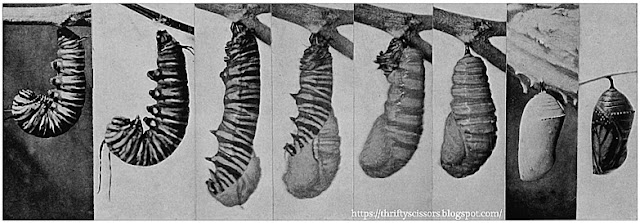 |
| The monarch caterpillars. |
Required for Observation In The Classroom: A diagram, illustrating the metamorphoses of a caterpillar, will be necessary while giving this lesson; but the changes should be studied from the insects themselves.
The eggs and the young caterpillars of the common cabbage-butterfly may be found in any vegetable garden, on the leaves of cabbages, during April and May, and again about two months later (the second brood). The caterpillars may be fed on cabbage leaves, and observed from day to day.
If you cannot locate one of these in your garden at home there are companies that sell chrysalis for students to observe a butterfly transformation all over the web!
Method of Student Observation:
- Exhibit a cluster of the eggs, and also a picture of the egg as seen through a microscope.
- The structure of a caterpillar should be illustrated by diagram or video; but live caterpillars should also be exhibited.
- If the caterpillar of the cabbage- butterfly cannot be obtained, any other will do, for all are similar in their general characteristics, except that the number of claspers varies from two to five pairs.
- The process of molting should be observed if possible. The approach of molting-time may be known by the temporary fasting of the insect.
- A chrysalis should be exhibited, and, if possible, the final molting watched at intervals.
How to Grade Study Notes For Student Journals: Every student will need a journal to write in weekly for this online nature study series. Teacher will assign the weekly content in advance.
- Make sure the facts are: written in complete sentences, the first word of each sentence capitalized, and a period should be included at the end of each sentence.
- Spell check your vocabulary and write the words correctly.
- Dress up your journal entries with student clip art, drawings of your own in color or in black and white.
- Student may also include photographs of their own taking for extra credit.
Look for the following facts about caterpillars inside of student journals. Assign a point value to the quality of the content.
- Eggs - Laid by butterflies on the proper food-plants. Attached by a gummy substance.
- Structure - Body made up of several segments, the number usually given as thirteen, counting the head as the first.
- Head - Covered with a hard skin. A pair of jaws. Twelve very small eyes.
- Limbs - Six legs one pair on each of the 2nd, 3rd, and 4th segments. In addition to these legs, the caterpillar has five pairs of pro- legs, each one provided with a circlet of little hooks. The pro-legs are often spoken of as the claspers.
- Moulting - A caterpillar casts its skin several times during its growth. The old skin splits, and reveals a new one beneath.
- Final Moult - This occurs when the caterpillar is full grown, and the insect then appears as a chrysalis.
Video at Youtube for Students to Watch:
- Watch a Monarch Caterpillar Change into A Chrysalis by The Jefferson Lab
- What's inside a caterpillar ''cocoon? ''
Make Graphic Illustration of Caterpillar Metamorphosis: Draw from real-life observation or from a video or the photograph below.
''This caterpillar of the monarch butterfly-hanging head downward-is ready for the metamorphosis. It hatched from a minute egg in late summer and has grown for two weeks. It stopped eating and wandered restlessly about and has now chosen a secure spot on which it has spun a small thick carpet of silk. It walked over this until the hind feet with their many minute hooks were entangled in the silk, then letting go its hold with the other pairs of feet, it hung head downward, motionless. The skin now loosens, and after twenty-four hours splits over the head. At this stage the caterpillar becomes active: by muscular contraction it works the skin off upward into a small shriveled mass; then during the few seconds longer that it still remains attached to the skin, it reaches out its slender end (which also is supplied with hooks) and with great effort and force pushes it up into the silk carpet. the whole process has taken but three or four minutes by the watch. The creature now rests. Slowly the shape changes, the segments above contracting, the form rounding out; and behold an emerald-green chrysalis studded with gold spots! In this form the insect is wholly immovable-although wonderful changes are taking place within, absorption of structures useful to the caterpillar and perfecting of others necessary for the new life of the butterfly. In two weeks the pattern of the butterfly's brown and orange wings begins to show through, finally the chrysalis skin, in its turn, splits over the head, and the butterfly crawls out. Such is one of the simplest and best-known stories of insect metamorphosis.''
Arts/Crafts Projects:
- Make my caterpillar stick puppet... - 4th, 5th, and 6th Graders
- Craft a pom-pom caterpillar SWAPS for girl scouts here - 1rst -5th Grade
- Make a very hungry caterpillar... - kindergarten through 2nd grade
Extended Learning Content:
- The Cocoon - Bible Lesson based upon the transformation of a caterpillar into a butterfly.
- Caterpillar On The Wall - illustrated poem
Free Student Clip Art: Clip art may be printed from a home computer, a classroom computer or from a computer at a library and/or a local printing service provider. This may be done from multiple locations as needed because our education blog is online and available to the general public.
 |
| Illustrations of Caterpillars, their eggs on a leaf, their chrysalis, and anatomy like: head, legs and claspers. |



No comments:
Post a Comment
Folks, thanks for comments. These are all checked out before publishing. I can not publish spam, doing this negatively reflects upon 'how' my blog ranks and it also will make you look suspicious to those who own this software.